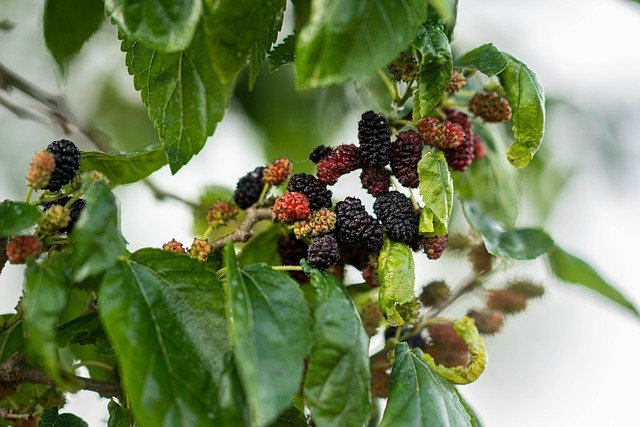When Do Mulberry Trees Bloom? —Knowing the Best Time To Harvest

Mulberry trees typically bloom during the late spring or early summer (from late March to early June), but this can vary depending on the location. Generally, however, mulberry trees will start to blossom around the second week of May in the Northern Hemisphere and the third week of May in the Southern Hemisphere. Once the flowers have opened, they will start to turn into fruits eaten by birds and other animals.
The mulberry tree is a hardy plant that can grow in various climates and soil conditions. It is also easy to propagate, so if you would like to grow a mulberry tree of your own, all you need to do is purchase a healthy sapling from a nursery or online store and start planting it. Mulberry trees are a great addition to any garden because they are not fussy about soil conditions and can tolerate wet and windy conditions.
Table of Contents
Characteristics of Mulberry Bloom
Mulberry trees can be either dioecious or monoecious, and they can sometimes switch from one to the other. The flowers are on short, green, hanging, unremarkable catkins that grow in the axils of new growth and on spurs on older wood. A few catkins grow from buds on 1-year-old branches around the same time as the leaves. When in bloom, the male catkins rise or hang down. They are between 3/4 and 2 inches long, green or yellowish, and each flower in the cluster has 4 stamens.
Female catkins are upright or rising, more compact, oval to short-cylindrical, and up to 3/8 inch long. The flower color is yellowish-green. Each flower has an oval, green ovary that is slightly flattened and a two-part style that is white to red. Both male and female catkins have hairy cluster stalks.
The wind pollinates them, and some varieties will set fruit even if they aren’t pollinated. There is no need for cross-pollination. In California, mulberries produce fruit even if they aren’t pollinated.
How to Make Mulberry Bloom
Most people don’t want their mulberry trees to bloom because the flowers aren’t very pretty, and the fruits are messy and useless unless you want to use them to make jams, jellies, or other foods. But if you want the tree to bloom and produce fruit, all you have to do is make sure it gets enough sunlight, gets watered regularly, and gets fertilized once a year.
Most mulberry trees don’t bloom or bear fruit because the soil doesn’t have enough nutrients, or a late spring frost kills the flower buds.
Mulberry Growth Habit
Mulberry trees come in a variety of sizes and are three distinct species. Among the white mulberries, which can reach a height of 80 feet and take on a variety of shapes and sizes, the most drooping and pyramidal varieties exist. The red mulberry can grow up to 70 feet tall in the South, thriving on rich soil. Black mulberry is the smallest of the three, reaching a maximum height of 30 feet, but it will grow into a bush if it is not trained when it is young. The life expectancy of different species varies greatly. As far as we know, black and red mulberry trees have been known to produce fruit for hundreds of years. The mulberry is a beautiful tree that can produce fruit while still young and in full bloom.
Mulberry Fruit After Bloom
The fruit is not an individual berry but rather a swollen loganberry in terms of botany. Flowers and their fleshy bases swell after pollination. Succulent, fat, and dripping with juice result from this radical transformation. These flowers look like blackberries, but they’re much smaller and more delicate than the blackberries themselves. The mulberry species cannot be determined by looking at the color of the fruit. Mulberries, such as white mulberries, can bear fruit in white, lavender, or even black. White mulberry fruits are very sweet, but the tartness is often lacking. Typically, red mulberry fruit is a deep red, almost black color, with an almost identical flavor to the black mulberry in the best clones. This is the best-tasting variety of mulberry, with large, juicy fruits and a good balance of sweetness and tartness. Grapefruit-like flavors are present in the refreshingly tart taste. As opposed to many other fruits, the ripening of mulberries takes a long time.
The Best Time to Harvest
Late in the spring, white and red mulberry fruits (and hybrid varieties) are ready for picking. In the summer and into the fall, black mulberries produce fruit. Traditionally, harvesting white mulberries involves spreading a sheet across the ground and shakin’ the branches. A surprising amount of wood can be harvested from a relatively young and small tree. Picking black mulberry berries is more complicated. Hands (and clothing) get stained with blood-red juice as the berries collapse when squeezed to release the seeds. The unwashed berries can be stored in a covered container in the refrigerator for several days. Sugar, malic and citric acids make up about 9 percent of the sugar in ripe black mulberry fruits. As with other berries, you can either eat the berries or use them in any way other berries are used. Pies and tarts are best made with slightly ripe fruits. Mulberries go well with pears and apples, but they also work well independently. These fruits can also be used to make wine, and the black ones are particularly good dried.
References:
Hughes, A. (2022, May 8). How to Grow and Care for Mulberry Trees. The Spruce; www.thespruce.com. https://www.thespruce.com/growing-mulberry-trees-5077354
Morus alba (White Mulberry): Minnesota Wildflowers. (n.d.). Morus Alba (White Mulberry): Minnesota Wildflowers; www.minnesotawildflowers.info. Retrieved May 11, 2022, from https://www.minnesotawildflowers.info/tree/white-mulberry
Mulberry – California Rare Fruit Growers, Inc. (2016, July 22). Mulberry – California Rare Fruit Growers, Inc.; crfg.org. https://crfg.org/wiki/fruit/mulberry/
